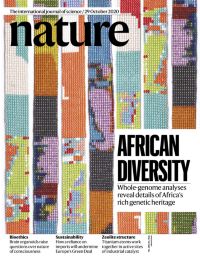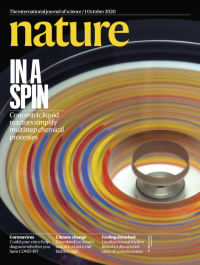Volume 586
-
No. 7831 29 October 2020
African diversityAlthough Africa is regarded as the cradle of modern humans, only a fraction of the genetic diversity among African individuals has been surveyed. In this week’s issue, Zané Lombard, Adebowale Adeyemo, Neil Hanchard and their colleagues from the H3Africa Consortium help to redress this imbalance by presenting whole-genome sequence analyses of 426 individuals covering 50 ethnolinguistic groups. The researchers uncovered more than three million new variants, mostly among newly sampled groups, and identified 62 previously unreported genes associated with viral immunity, DNA repair and metabolism. They also observed complex patterns of ancestral mixing within and between populations, and found evidence that Zambia was a likely intermediate site along the routes of expansion for Bantu-speaking populations. The findings help to refine understanding of migration across the African continent and identify gene flow and response to disease as strong drivers of genome-level population variation. The cover shows a subset of the genetic data collected in the study translated into hand-loomed beaded necklaces by the Marigold beadwork cooperative in Zimbabwe.
-
No. 7830 22 October 2020
Vaccine designThe cover image draws on aspects of Bauhaus artist Paul Klee’s famous notebooks to reimagine the quest for a vaccine against SARS-CoV-2. The drive to create an effective vaccine to mitigate the COVID-19 pandemic has seen researchers move from genetic sequence of the virus to clinical trials at unprecedented speed. This week’s issue features a number of papers that probe design strategies and clinical trial results for vaccine candidates to combat the virus. In addition, a Review presents a round-up of vaccines in development, noting that signs so far suggest that a safe and effective vaccine could be realized on a timescale of months rather than years.
Nature Outlook
-
No. 7829 15 October 2020
Turning up the heatSuperconductors, materials that conduct electricity with zero resistance below a critical temperature, have been known since the early twentieth century. But for decades it was believed the phenomenon was restricted to temperatures close to absolute zero. With the discovery of high-temperature superconductors in the 1980s, that idea was overthrown — even though the high temperatures in question were of the order of −140 °C. Since then, the quest for materials that superconduct at ever-higher temperatures has flourished, and in this week’s issue, Ranga Dias and his colleagues realize a long-sought milestone: a material that superconducts at room temperature. The researchers generated a photochemically transformed carbonaceous sulfur hydride system that shows superconductivity at around 15 °C. At this point, the phenomenon still requires high pressures of at least 270 gigapascals, but the team believes that chemical tuning of the system will allow superconductivity to be achieved at lower pressures.
Nature Outlook
-
No. 7828 8 October 2020
Gut profilesThe cover image shows organoids grown from a mouse adult intestinal stem cell stained for differentiated and proliferating cells. Such organoids are increasingly being used to study organ development and physiology, as well as finding applications in testing new drugs. In this week’s issue, Prisca Liberali and her colleagues present an organoid-based screening platform, which they used to identify compounds that promote intestinal regeneration. By generating phenotypic fingerprints for hundreds of thousands of organoids, the researchers were able to map genetic interactions involved in cell fate and regeneration. They found that differentiation of the cells lining the gut relies on retinoic acid signalling, and that inhibiting a cell receptor for retinoic acid can improve intestinal regeneration.
-
No. 7827 1 October 2020
In a spinFlasks have long been the fundamental piece of equipment for chemical syntheses and separations. In recent years, batch-reactor and flow-based systems have been created to run multistep processes without the need for manual handling or intermediates, but both approaches require a high degree of precision engineering to set up and control. In this week’s issue, Bartosz Grzybowski and his colleagues present rotating chemical reactors based on self-organizing concentric layers of immiscible or pairwise-immiscible liquids, each hundreds of micrometres to millimetres thick. Multiple steps in a process are dictated by the ordering of the layers and transport is facilitated by mixing through periodic variations in the reactor’s rotational speed. The team demonstrates the use of the liquid reactors in multistep chemical syntheses, simultaneous acid-base extractions and the separation of complex reaction mixtures.





